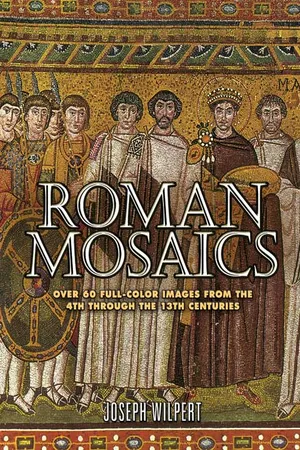
eBook - ePub
Roman Mosaics
Over 60 Full-Color Images from the 4th Through the 13th Centuries
- 64 pages
- English
- ePUB (mobile friendly)
- Available on iOS & Android
eBook - ePub
About this book
In many of the Italian Christian churches in the vicinity of Rome, mosaics were an important aspect of decoration. This full-color collection includes some of the finest examples of those mosaics.
Filled with scenes taken directly from biblical myth and literature, the book spotlights more than sixty mosaic masterpieces created by Italian craftsmen from the fourth through the thirteenth centuries. A third of the images are from the Old Testament, illustrating such stories as Abraham and the angels, Jacob and Rachel, Moses and the burning bush, Pharaoh's army drowning in the Red Sea, and Joshua and the battle of Jericho. Most of the remaining mosaics feature New Testament themes or characters: the birth of Jesus, calling for apostles, multiplying the loaves and fishes, and more. Roman Mosaics is a magnificent book for browsing through, and will appeal to art historians, mosaic artists, and religious scholars.
Filled with scenes taken directly from biblical myth and literature, the book spotlights more than sixty mosaic masterpieces created by Italian craftsmen from the fourth through the thirteenth centuries. A third of the images are from the Old Testament, illustrating such stories as Abraham and the angels, Jacob and Rachel, Moses and the burning bush, Pharaoh's army drowning in the Red Sea, and Joshua and the battle of Jericho. Most of the remaining mosaics feature New Testament themes or characters: the birth of Jesus, calling for apostles, multiplying the loaves and fishes, and more. Roman Mosaics is a magnificent book for browsing through, and will appeal to art historians, mosaic artists, and religious scholars.
Frequently asked questions
Yes, you can cancel anytime from the Subscription tab in your account settings on the Perlego website. Your subscription will stay active until the end of your current billing period. Learn how to cancel your subscription.
No, books cannot be downloaded as external files, such as PDFs, for use outside of Perlego. However, you can download books within the Perlego app for offline reading on mobile or tablet. Learn more here.
Perlego offers two plans: Essential and Complete
- Essential is ideal for learners and professionals who enjoy exploring a wide range of subjects. Access the Essential Library with 800,000+ trusted titles and best-sellers across business, personal growth, and the humanities. Includes unlimited reading time and Standard Read Aloud voice.
- Complete: Perfect for advanced learners and researchers needing full, unrestricted access. Unlock 1.4M+ books across hundreds of subjects, including academic and specialized titles. The Complete Plan also includes advanced features like Premium Read Aloud and Research Assistant.
We are an online textbook subscription service, where you can get access to an entire online library for less than the price of a single book per month. With over 1 million books across 1000+ topics, we’ve got you covered! Learn more here.
Look out for the read-aloud symbol on your next book to see if you can listen to it. The read-aloud tool reads text aloud for you, highlighting the text as it is being read. You can pause it, speed it up and slow it down. Learn more here.
Yes! You can use the Perlego app on both iOS or Android devices to read anytime, anywhere — even offline. Perfect for commutes or when you’re on the go.
Please note we cannot support devices running on iOS 13 and Android 7 or earlier. Learn more about using the app.
Please note we cannot support devices running on iOS 13 and Android 7 or earlier. Learn more about using the app.
Yes, you can access Roman Mosaics by Joseph Wilpert in PDF and/or ePUB format, as well as other popular books in Art & History of Ancient Art. We have over one million books available in our catalogue for you to explore.
Information
NOTE
The mosaics featured in this book are all early Christian and originated in various Italian cities, although the vast majority are from Rome. Derived from an influential early work on the subject, Die römischen Mosaiken und Malereien der kirchlichen Bauten vom IV.—XIII. Jahrhundert (1916) by Joseph Wilpert, all works shown here may be considered among the most significant examples of the genre. Many of the exhibited mosaics are extant and open to visitors.
Christian mosaic art grew out of Roman pagan practice, which could be decorative or religious. While earlier Roman work prominently featured floor designs (with some wall and vault mosaics appearing in the early centuries A.D.), Christians made the first use of mosaics for large-scale murals, and were also the first to master color effects using glass tesserae (the individual pieces of a mosaic).1 Glass brought intense color to the art but was better suited for walls than floors because it was more fragile than the marble or stone of prior mosaic styles.
Early mosaics were usually executed on site. In some cases, a layer of plaster was placed over the usual cement base and a drawing was made on the plaster. As the mosaic progressed, the plaster was slowly replaced with tesserae and binding cement. In other cases, a drawing was made directly on the cement.2 The amount of cement used was significant: too much of it would cause a mosaic to prematurely deteriorate. Placement of individual pieces was important, as much of the beauty of mosaic art is dependent on the proper reflection of light against its respective tesserae—therefore these were carefully placed, usually tilted at an angle depending on the amount...
Table of contents
- Title Page
- Copyright Page
- Table of Contents
- NOTE